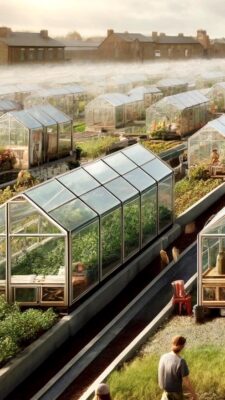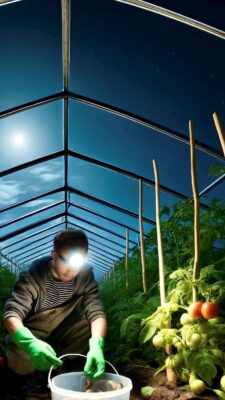Now that most open ground is waterlogged for much of the year, under-cover space is more precious than ever – and a group of ingenious growers have found a way to maximise the benefits.
Whooping, clapping, cursing, the clunk of metal on metal, and what sounded like a squeaking legion of wheelbarrows, crying out to be oiled, was an odd cacophony to hear at the gate to an allotment field – though I knew these weren’t just any old allotments. Gardening’s future was germinating here.
These were the first plots in the UK to receive climate resilience funding under the new Sustainable Social Gardening Initiative – already nicknamed SUSGAR – which was born when the penny finally dropped that gardeners, working alongside local food growers, were on the front line of helping communities to adapt to worsening climate and ecological breakdown. Not exactly ‘dig for victory’ – more of a ‘no-dig for local food resilience’ mouthful.
‘Cultivating resilience!’ – the battle cry of a growing nationwide army of susgardeners – was writ large on the gate.
I was late. The train had slowed to snail-pace crossing the waterlogged fields outside the town, their months-long grey sheen mirroring the sun-free sky; it was late May, and this area had seen only a handful of sunny days since last October. The endless rain that fell through the autumn, winter and spring of 2023/2024 had thrown a switch that wouldn’t go back.

From that tipping point, each autumn to spring got progressively wetter, one rainfall record tumbling after another. The farming and food shocks triggered back in 2024 became the norm, as our living world changed faster than even the brightest minds had dared imagine was possible. Almost a decade on, this is our soggy new normal.
A warm breeze buffeted my face with fine, hair-damping drizzle. This was what is now deemed a good spring day, allowing at least some work to be done outdoors, after months of incessant rain. High pressure, and the precious dry spells it once brought, are now almost myths once October arrives and the rains set in.
These allotments were blessed with sandy, free-draining soil, but at times the only cultivation anyone could do was under cover, in their greenhouses and polytunnels. Under-cover growing was saving the day for these gardeners, but it wasn’t enough to keep large expanses of the wet and unworkable allotment field planted and productive.
The rain made sowing and planting akin to the gardening version of Russian roulette while blindfolded; growing anything fell to pure luck. And following those few rare days when seeds and plug plants could go in, nocturnal hordes of slugs, swelled by warm, soggy winters, were ready and waiting to rasp. All-night head-torch mollusc patrols quickly became standard; natural predator populations are still in free-fall in our ecologically upending world.
Refusing to be defeated, some of the keenest under-cover gardeners started to join their structures together, testing their DIY skills to the limit. This created much larger growing areas, protected from whatever a chaotic climate threw at them. But one day, when a dozen burly blokes decided to lift a ‘communihouse’ – slang for community greenhouse – and carry it to another patch of ground, a game-changing gardening penny dropped.
What’s happened since is what was now laid out below me on the big flat allotment field; it’s covered in a motley collection of greenhouses, neatly arranged in a large square, with areas of open ground, some planted with crops, between them. At first glance it didn’t look so different from other allotments where every bit of ground is cropped, but then I saw it: some of the greenhouses were moving.
‘Go on, just use your hand. Push!’ urged Jack, one of the young susgardeners showing me around. The broad smile that spread across my face was matched by Jack’s as the big greenhouse – clearly constructed from several smaller ones – began to slide, squeakily, over the ground.

I single-handedly kept up its momentum as Jack pulled a lever, raising a clear skirting around the greenhouse’s base, liberating warm air. As it moved from over them, the frame of the house brushed against the soft haulms of a crop of new potatoes, growing in remarkably dryish-looking soil.
‘We can get these mulched up now,’ Jack explained. ‘We could only plant spuds by covering this area for a few weeks to dry it out first, but they should be good from here.’ The greenhouse stopped with a metallic clunk, rattling the glazing as it gently sprang back and came to a halt over a new piece of ground. ‘Cool, isn’t it?’ Jack pointed down to big metal springs acting like buffers.
We stepped inside the high-roofed greenhouse. ‘This patch has been too wet and cold to do anything with, so we’ll let it dry out and warm up a bit, then hoe off any weeds. The greenhouse will probably stay here for the summer, so we’ll plant bush tomatoes or peppers. We can’t move the houses once the crops are tall, so we tend to grow low.
‘It all took some puzzling out, and we’re still refining it,’ said Jack, showing me the metal wheels that allowed the greenhouses to slide along a network of narrows rails, from patch to patch. ‘Our team of sliders are trying to work out whether it’s better to have the houses lined up in rows and move them between whole strips of ground, or to keep them a bit more random, as they are now. They’re using AI to help figure some of it out – and the SUSGAR funding is helping too.’
Once a greenprint is ready, food-growing communities everywhere will be able to adapt it for their own land, Jack explained. His role was to work out cropping plans. ‘Our goal is to not have any piece of ground that can’t be used to grow something. It’s us against the weather, and we’re gonna win!’ He showed me drone footage of the site, looking for all the world like a giant chessboard with green, brown and glassy squares.
We wove our way along the narrow paths between the greenhouses, stopping every now and then to let one pass, the squeaking and clunking of the buffers becoming an oddly comforting soundtrack to the spring bustle. My cheeks warmed, and a communal cheer roared out as we all looked up to see a faint yellow disc appear fleetingly, before being lost again in the roiling clouds.
‘Come back, sun! Please!’ cried a young girl busy washing down some algae-coated glazing. The squeaking paused as we all cheered her on, clapping in unison, our palms stinging, under the endless grey sky.
Text © John Walker. Images: author imagination assisted by AI
Join John on X @earthFgardener










